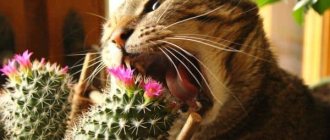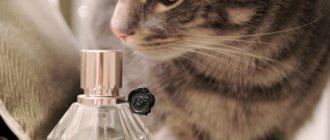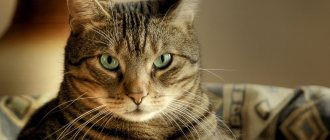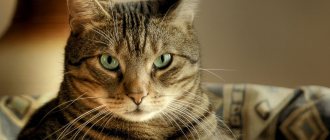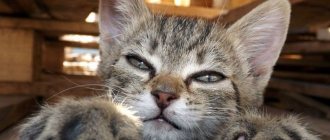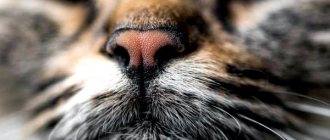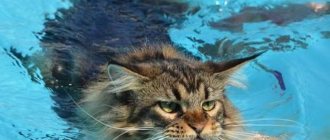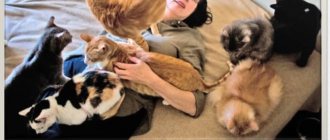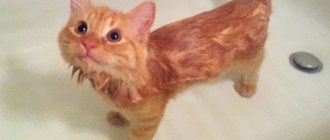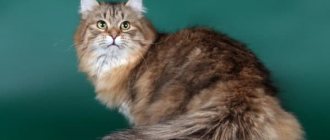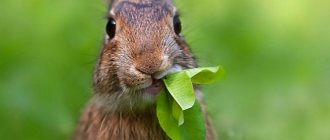Main mistakes when choosing a diet
One way or another, each owner chooses what he will feed his pet, but how to feed cats and cats correctly, what to focus on when choosing a diet?
The Internet, advice from friends, advertising are not the most reliable sources, and here you can fall into some kind of “traps”. For example, there is a popular misconception that the most cat-like food is fish. Yes, many cats love fish very much, but this product should not be abused, especially if the cat has a tendency to urolithiasis. Often, owners are guided by the tastes of the cat itself, without delving into the essence of the issue; such indulgence of the pet’s preferences can lead to serious consequences. Information from the manufacturer, when it comes to ready-made food, is partly of an advertising nature - this is the law of the market, so you should not blindly trust advertising either. You can contact a specialist, but when it comes to feeding a cat correctly, a veterinarian’s advice may not always be a panacea.
Firstly, there are not many veterinary nutritionists in Russia, and they cannot be found in every city. And sometimes even the most experienced veterinarian, who can operate on a cat with his eyes closed, will not be able to give complete advice on how to feed this cat. Secondly, veterinarians often collaborate with manufacturers and recommend their ready-made food because they receive financial benefits from it, and not at all because this particular product is suitable for the pet.
So, in order to approach feeding a pet responsibly, we must have an understanding of the cat’s digestion and physiology, and also learn to understand the composition, pros and cons of different types of food.
Table: healthy and prohibited foods in a cat’s diet
The table below lists foods that can and cannot be given to a cat:
| Healthy | Harmful |
| Meat other than pork | Bread and flour products |
| By-products | Legumes and soybeans |
| Vegetables with low starch content | Potatoes and corn |
| Sea fish | Sweets |
| Cereals: rice and buckwheat | Chicken hollow bones |
| Dairy products | Fruits |
| Greenery | Fresh milk |
How to feed cats and cats correctly?
Domestication has had no effect on the cat's digestion and enzyme system, and it still requires animal food. It is dishonest for the owner to neglect this, because the pet is completely dependent on the person in this matter. Therefore, before you have a furry friend at home, you need to figure out how to properly feed an adult cat, and a kitten too, based on the main thesis: they get all the substances necessary for life from animal protein and fat, which means that they should form the basis of their diet.
Vegetable protein, the source of which is cereals, which some manufacturers love to saturate their products with, is incomplete for cats, since it does not contain all the amino acids they need, including essential ones, which enter the body only with food. For example, plant protein completely lacks taurine, a chronic deficiency of which causes dilated cardiomyopathy (heart disease), and sooner or later leads to blindness and other pathologies, and then the death of the animal.
Animal fat contains essential fatty acids, such as arachidonic acid, which is involved in many body processes, and essential Omega-3 fatty acids.
What not to feed cats
Cats eat food from the human table with enviable pleasure, and many owners watch with emotion as the animal happily treats itself to candy or a piece of chocolate, licks ice cream or eats a slice of melon, peach, tomato, sausage, or cheese.
Of course, a one-time consumption of a small amount of products that are exotic for the cat’s body is unlikely to lead to a serious illness, but you cannot constantly give such products to an animal: this can cause a chronic disease and significantly reduce the pet’s life expectancy.
The following foods should not be included in cat food:
- Fresh milk - this leads to impaired intestinal motility and indigestion.
- Food from the table - salt and seasonings contained in human food can even cause poisoning. And sausage, for example, contains soy products and a lot of fats, which are harmful to the cat's health.
- Sweets - carbohydrates are harmful to cats, since sugar is not processed at all by the digestive system.
- Coffee and alcohol are poisons for animals.
- Raw unprocessed meat and river fish - it is better to give the meat boiled or at least pour boiling water over it, since there is a high possibility of infection with helminths. River fish can be present in a cat's food only in boiled form, with selected bones.
- Pork – contains too much fat that the animal’s stomach may not be able to handle.
- Tubular or sharp bones - damage to the esophagus or stomach will definitely lead to the death of the pet.
Eating such products by an animal will inevitably lead to illness and deterioration in health.
Veterinarian advice
There are several tips that experienced veterinarians give to cat owners who want to feed their pets natural products:
- You cannot feed fermented milk and meat products to an animal at the same feeding. Fermented milk products are given at one meal, and meat at another.
- Fermented milk products can be given separately or mixed together; only bran or half a raw egg can be added to them.
- Meat feeding is either meat, fish, or offal. You should not mix foods in one feeding.
The cat should always have a bowl of clean, fresh water: the animal should be able to replenish the lack of moisture in the body when it needs it.
Flour foods and diabetes
If an animal has a disease such as diabetes, then flour food is strictly contraindicated for it. A carbohydrate-free diet is indicated for feeding animals with this disease.
Eating food high in carbohydrates will aggravate the disease and may lead to the death of the animal.
Attention! Cats are not recommended to eat food containing large amounts of carbohydrates.
Clean meat is not the answer
It would seem simple to provide a cat with all this, because now a wide range of fresh meat is available in stores and markets. But it's not that simple. In nature, a cat eats its prey entirely: with bones, internal organs, including the contents of the stomach, connective tissues, blood and fur. With all this, the animal receives not only proteins and fats, but also a full range of vitamins, macro- and microelements, fiber and other important substances. In the store, you will only buy muscle meat, possibly with fat, as well as a limited set of offal.
From this, if you understand the issue, you can create a complete diet by adding sources of fiber, Omega-3 fatty acids (best in the form of fish oil, as its richest source), and a vitamin and mineral complex. However, all this is troublesome and quite expensive, which is why owners today so often choose ready-made industrial diets in the form of canned food or dry food, and there is nothing wrong with this if you understand the main thing - all these products must meet the same requirements as natural diets, that is, to best meet the physiological needs of the cat.
When looking for such a diet, you can use the “Feed your pet correctly” service, here you will find ratings and detailed descriptions of many dry and wet foods, compiled by specialists according to certain criteria. You can also read separately about each of the more than a thousand ingredients used in animal feed in our database.
Separately, it is worth mentioning cases when a standard diet is not suitable for a pet. In particular, cats suffering from kidney and liver diseases, urolithiasis, obesity and other problems require a special veterinary diet. In this case, when deciding how to properly feed your cat, only a veterinarian can provide professional assistance. Moreover, the choice of diet required by the animal is made only after an examination and a series of tests.
Is it possible to treat a cat: conclusions
If your cat is not prone to whims when it comes to food, why not occasionally pamper him with treats? A treat is one of the manifestations of the owner’s love for the pet, which is important for both parties. The main thing is to make sure that “goodies” take up no more than ten percent of the daily diet.
In addition to dry food, you can offer your cat specialized meat treats that are produced specifically for animals (for example, Orijen treats), as well as any protein products: meat, fish, poultry, eggs, cottage cheese. But these should not be dishes prepared for humans - with lots of seasonings, salt, smoked.
Moreover, you should not give your cat sweets, flour, cereals, or pasta. Excess carbohydrates in a carnivore's diet are associated with an increased risk of a number of diseases. Therefore, it is better to leave the cat without any treats at all than to offer him food that could harm him.
When and how much food to give?
It is enough to feed an adult healthy cat twice a day, it is better to do this at approximately the same time in the morning and evening. When determining the daily food intake, you should not focus on the cat’s appetite: all cats are different, and if one is happy to eat almost around the clock, then feeding another, on the contrary, is a big problem. At the same time, the needs for calories and nutrients for both are on average approximately the same, although to some extent they depend on certain factors.
On average, the daily food intake for natural feeding should be 5% of the weight of the cat itself, if we are talking about an adult animal. If we are talking about dry food, then manufacturers always place information on the packaging on how to calculate the food depending on the weight of the animal. For a more accurate calculation, the pet must be weighed regularly.
How to switch an animal to natural food
It’s good when a kitten is accustomed to natural products from childhood, but it is quite possible to retrain a cat that is accustomed to dry food. If you change food suddenly, the animal may become stubborn, refuse to eat and go hungry for several days. To make the transition painless, you will have to try a little.
Natural food should be mixed in a small amount into the daily portion of dry food, replacing approximately 10% at first. Gradually, the share of natural food should be increased, and dry food should be reduced. After two weeks, you can completely switch to natural nutrition.
Drinking regime
When asking how to properly feed an adult cat, you must remember that in addition to food, he must also receive a sufficient amount of liquid. Why do cats need water? The species of small feline predators, the distant ancestors of today's domestic cats, was evolutionarily formed in desert areas under conditions of severe lack of moisture; their body conserves liquid, so the urine of cats is naturally highly concentrated.
The problem is aggravated by the fact that they have a reduced sense of thirst - probably all owners of tailed friends have noticed that their pets drink a little. That is why fresh water should always be available to the animal. However, do not be surprised if the cat does not drink water from a bowl located next to the place where it eats. In the wild, representatives of the cat family do not drink water near the killed victim; they prefer to look for clean sources of drinking water in the distance. Many pets still have this instinct. It is best to place containers with water in different parts of the apartment - sooner or later the cat will find one or more places that are comfortable for itself.
Some cats prefer running water; in such cases, a special fountain that provides constant circulation and purification of water can be a solution. Some homeowners leave a small stream in the sink, but we do not recommend following this example unless the tap has a built-in filter. The fact is that tap water contains a lot of salts and impurities, which can lead to ICD.
The average daily fluid intake per 1 kg of animal should be 30 ml of water, but you need to take into account what kind of food the cat receives. With a dry diet, the amount of water should be 2-3 times greater than the amount of food eaten; when feeding with natural food or wet food, the need for drinking water is reduced. If your cat refuses to drink water, despite all your efforts, you will have to exclude dry food and try to compensate for the cat’s body’s need for fluid with wet food.
Natural products for adult cats
Proper treatment helps prevent eating disorders and helminth infections:
- Raw meat is pre-frozen for a week to destroy parasites and bacteria; before serving, it is cut into cubes up to 2 cm and scalded with boiling water. When cooking, add so much water so that it only covers the product - this way more vitamins are preserved. The ratio of nutritional components differs between species, so you cannot feed one all the time.
- By-products are processed in the same way as meat and added to the diet twice a week. They contain useful microelements that are absent in muscle fibers.
- Vegetables are given after heat treatment or raw: grated and added to meat products in a ratio of 1 to 3. It is useful to boil them in meat broth.
- Eggs are allowed only after heat treatment; raw protein contains an enzyme that destroys biotin. They are introduced into the diet 2 times a week and crushed before serving.
- Cereals are boiled in water or poured with boiling water and left to swell for 7–8 hours. Porridge is mixed with meat food.
- The fish is boiled, bones are removed and included in the diet once a week.
A detailed list of permitted products is indicated in the following table:
| Raw and cooked: | Fresh: | After heat treatment: |
|
|
|
Products with excess fat, harmful and irritating gastrointestinal components are excluded from the diet.
These include:
- pork;
- salo;
- mutton;
- duck;
- goose;
- minced meat from the store;
- bones;
- river and fatty varieties of sea fish;
- garlic;
- citrus;
- grape;
- beans;
- soy;
- peas;
- onion;
- sausage;
- fried and smoked foods;
- chocolate;
- sugar and sweets;
- bakery;
- avocado;
- salt.
With natural feeding, it is difficult to balance the diet so that the pet receives all the necessary micronutrients, so they are given additionally.
The following vitamins are vital for the cat's body:
- A – retinol promotes cell growth and regeneration, maintains visual acuity and hair thickness.
- B1 – thiamine is involved in the functioning of the nervous, digestive, and muscular systems.
- B2 – riboflavin affects the physical condition and respiratory system.
- B5 – pantothenic acid is required for normal metabolism and is responsible for hair pigmentation.
- B6 – pyridoxine is involved in protein and fat metabolism.
- B12 – cyanocobalamin affects the level of hemoglobin in the blood.
- C – ascorbic acid regulates immunity, metabolic processes, and helps cope with pathogenic microorganisms.
- D – calciferol promotes the accumulation of calcium and the normal development of bone tissue.
- E – tocopherol delivers oxygen to cells and supports the functioning of reproductive organs.
- H – biotin affects the metabolism of the skin, the condition of the epidermis and hair.
- K – phylloquinone is responsible for the level of blood clotting.
Vitamins for cats are purchased from veterinary pharmacies; human preparations are contraindicated. They are given in prophylactic doses; only a doctor prescribes them for therapeutic purposes.
conclusions
So, the health and longevity of a cat depends on a properly selected balanced diet. The basis for determining how to properly feed an adult cat is an understanding of its individual characteristics and the characteristics of its physiology as a biological species. Any cat, first of all, needs products of animal origin, supplemented with a vitamin and mineral premix. In general, any owner of a tailed friend is able to independently choose the right diet for their pet, however, in some cases, animals require a special diet, which can only be prescribed by a specialist.
Sample recipes for cats
Cooking for cats is not difficult, the main thing is that you don’t need to add salt, pepper or sugar:
- Mix low-fat cottage cheese with half a chicken egg, and the dish is ready.
- Finely chop the vegetables, boil and mash with a fork, add finely chopped meat or minced meat, a few drops of vegetable oil. You can give it in the form of porridge, or you can dilute it with broth.
- Finely chop the offal and mix with finely grated vegetables.
- Cut the chicken meat into pieces and boil for ten minutes in a small amount of broth, add a little buckwheat or rice and after a couple of minutes turn off the stove, leave under the closed lid for about twenty minutes.
It is not necessary to cook for your pet at once; you can store the prepared food in the refrigerator. Warm the food to room temperature before serving.
